+ Open data
Open data
- Basic information
Basic information
| Entry | Database: EMDB / ID: EMD-23833 | |||||||||
|---|---|---|---|---|---|---|---|---|---|---|
| Title | Human CTPS2 bound to CTP | |||||||||
 Map data Map data | Human CTPS2 bound to CTP | |||||||||
 Sample Sample |
| |||||||||
 Keywords Keywords | glutaminase / amidoligase / nucleotide metabolism / LIGASE | |||||||||
| Function / homology |  Function and homology information Function and homology informationcytoophidium / CTP synthase (glutamine hydrolysing) / CTP synthase activity / pyrimidine nucleotide metabolic process / 'de novo' CTP biosynthetic process / pyrimidine nucleobase biosynthetic process / Interconversion of nucleotide di- and triphosphates / CTP biosynthetic process / glutamine metabolic process / ATP binding ...cytoophidium / CTP synthase (glutamine hydrolysing) / CTP synthase activity / pyrimidine nucleotide metabolic process / 'de novo' CTP biosynthetic process / pyrimidine nucleobase biosynthetic process / Interconversion of nucleotide di- and triphosphates / CTP biosynthetic process / glutamine metabolic process / ATP binding / identical protein binding / cytosol / cytoplasm Similarity search - Function | |||||||||
| Biological species |  Homo sapiens (human) Homo sapiens (human) | |||||||||
| Method | single particle reconstruction / cryo EM / Resolution: 2.8 Å | |||||||||
 Authors Authors | Lynch EM / Kollman JM | |||||||||
| Funding support |  United States, 1 items United States, 1 items
| |||||||||
 Citation Citation |  Journal: Proc Natl Acad Sci U S A / Year: 2021 Journal: Proc Natl Acad Sci U S A / Year: 2021Title: Structural basis for isoform-specific inhibition of human CTPS1. Authors: Eric M Lynch / Michael A DiMattia / Steven Albanese / Gydo C P van Zundert / Jesse M Hansen / Joel D Quispe / Madison A Kennedy / Andreas Verras / Kenneth Borrelli / Angela V Toms / Neelu ...Authors: Eric M Lynch / Michael A DiMattia / Steven Albanese / Gydo C P van Zundert / Jesse M Hansen / Joel D Quispe / Madison A Kennedy / Andreas Verras / Kenneth Borrelli / Angela V Toms / Neelu Kaila / Kevin D Kreutter / Joshua J McElwee / Justin M Kollman /  Abstract: Cytidine triphosphate synthase 1 (CTPS1) is necessary for an effective immune response, as revealed by severe immunodeficiency in CTPS1-deficient individuals [E. Martin ], [] [510], [288-292] ([2014]) ...Cytidine triphosphate synthase 1 (CTPS1) is necessary for an effective immune response, as revealed by severe immunodeficiency in CTPS1-deficient individuals [E. Martin ], [] [510], [288-292] ([2014]). CTPS1 expression is up-regulated in activated lymphocytes to expand CTP pools [E. Martin ], [] [510], [288-292] ([2014]), satisfying increased demand for nucleic acid and lipid synthesis [L. D. Fairbanks, M. Bofill, K. Ruckemann, H. A. Simmonds], [ ] [270], [29682-29689] ([1995]). Demand for CTP in other tissues is met by the CTPS2 isoform and nucleoside salvage pathways [E. Martin ], [] [510], [288-292] ([2014]). Selective inhibition of the proliferative CTPS1 isoform is therefore desirable in the treatment of immune disorders and lymphocyte cancers, but little is known about differences in regulation of the isoforms or mechanisms of known inhibitors. We show that CTP regulates both isoforms by binding in two sites that clash with substrates. CTPS1 is less sensitive to CTP feedback inhibition, consistent with its role in increasing CTP levels in proliferation. We also characterize recently reported small-molecule inhibitors, both CTPS1 selective and nonselective. Cryo-electron microscopy (cryo-EM) structures reveal these inhibitors mimic CTP binding in one inhibitory site, where a single amino acid substitution explains selectivity for CTPS1. The inhibitors bind to CTPS assembled into large-scale filaments, which for CTPS1 normally represents a hyperactive form of the enzyme [E. M. Lynch ], [] [24], [507-514] ([2017]). This highlights the utility of cryo-EM in drug discovery, particularly for cases in which targets form large multimeric assemblies not amenable to structure determination by other techniques. Both inhibitors also inhibit the proliferation of human primary T cells. The mechanisms of selective inhibition of CTPS1 lay the foundation for the design of immunosuppressive therapies. | |||||||||
| History |
|
- Structure visualization
Structure visualization
| Movie |
 Movie viewer Movie viewer |
|---|---|
| Structure viewer | EM map:  SurfView SurfView Molmil Molmil Jmol/JSmol Jmol/JSmol |
| Supplemental images |
- Downloads & links
Downloads & links
-EMDB archive
| Map data |  emd_23833.map.gz emd_23833.map.gz | 4.6 MB |  EMDB map data format EMDB map data format | |
|---|---|---|---|---|
| Header (meta data) |  emd-23833-v30.xml emd-23833-v30.xml emd-23833.xml emd-23833.xml | 11.1 KB 11.1 KB | Display Display |  EMDB header EMDB header |
| Images |  emd_23833.png emd_23833.png | 193.7 KB | ||
| Filedesc metadata |  emd-23833.cif.gz emd-23833.cif.gz | 5.4 KB | ||
| Archive directory |  http://ftp.pdbj.org/pub/emdb/structures/EMD-23833 http://ftp.pdbj.org/pub/emdb/structures/EMD-23833 ftp://ftp.pdbj.org/pub/emdb/structures/EMD-23833 ftp://ftp.pdbj.org/pub/emdb/structures/EMD-23833 | HTTPS FTP |
-Related structure data
| Related structure data |  7mh1MC  7mgzC  7mh0C  7mifC  7migC  7mihC  7miiC  7mipC  7miuC  7mivC M: atomic model generated by this map C: citing same article ( |
|---|---|
| Similar structure data |
- Links
Links
| EMDB pages |  EMDB (EBI/PDBe) / EMDB (EBI/PDBe) /  EMDataResource EMDataResource |
|---|---|
| Related items in Molecule of the Month |
- Map
Map
| File |  Download / File: emd_23833.map.gz / Format: CCP4 / Size: 103 MB / Type: IMAGE STORED AS FLOATING POINT NUMBER (4 BYTES) Download / File: emd_23833.map.gz / Format: CCP4 / Size: 103 MB / Type: IMAGE STORED AS FLOATING POINT NUMBER (4 BYTES) | ||||||||||||||||||||||||||||||||||||||||||||||||||||||||||||||||||||
|---|---|---|---|---|---|---|---|---|---|---|---|---|---|---|---|---|---|---|---|---|---|---|---|---|---|---|---|---|---|---|---|---|---|---|---|---|---|---|---|---|---|---|---|---|---|---|---|---|---|---|---|---|---|---|---|---|---|---|---|---|---|---|---|---|---|---|---|---|---|
| Annotation | Human CTPS2 bound to CTP | ||||||||||||||||||||||||||||||||||||||||||||||||||||||||||||||||||||
| Projections & slices | Image control
Images are generated by Spider. | ||||||||||||||||||||||||||||||||||||||||||||||||||||||||||||||||||||
| Voxel size | X=Y=Z: 1.05 Å | ||||||||||||||||||||||||||||||||||||||||||||||||||||||||||||||||||||
| Density |
| ||||||||||||||||||||||||||||||||||||||||||||||||||||||||||||||||||||
| Symmetry | Space group: 1 | ||||||||||||||||||||||||||||||||||||||||||||||||||||||||||||||||||||
| Details | EMDB XML:
CCP4 map header:
| ||||||||||||||||||||||||||||||||||||||||||||||||||||||||||||||||||||
-Supplemental data
- Sample components
Sample components
-Entire : CTPS2 tetramer
| Entire | Name: CTPS2 tetramer |
|---|---|
| Components |
|
-Supramolecule #1: CTPS2 tetramer
| Supramolecule | Name: CTPS2 tetramer / type: complex / ID: 1 / Parent: 0 / Macromolecule list: #1 |
|---|---|
| Source (natural) | Organism:  Homo sapiens (human) Homo sapiens (human) |
-Macromolecule #1: CTP synthase 2
| Macromolecule | Name: CTP synthase 2 / type: protein_or_peptide / ID: 1 / Number of copies: 4 / Enantiomer: LEVO / EC number: CTP synthase (glutamine hydrolysing) |
|---|---|
| Source (natural) | Organism:  Homo sapiens (human) Homo sapiens (human) |
| Molecular weight | Theoretical: 65.75943 KDa |
| Recombinant expression | Organism:  |
| Sequence | String: MKYILVTGGV ISGIGKGIIA SSIGTILKSC GLRVTAIKID PYINIDAGTF SPYEHGEVFV LNDGGEVDLD LGNYERFLDI NLYKDNNIT TGKIYQHVIN KERRGDYLGK TVQVVPHITD AVQEWVMNQA KVPVDGNKEE PQICVIELGG TIGDIEGMPF V EAFRQFQF ...String: MKYILVTGGV ISGIGKGIIA SSIGTILKSC GLRVTAIKID PYINIDAGTF SPYEHGEVFV LNDGGEVDLD LGNYERFLDI NLYKDNNIT TGKIYQHVIN KERRGDYLGK TVQVVPHITD AVQEWVMNQA KVPVDGNKEE PQICVIELGG TIGDIEGMPF V EAFRQFQF KAKRENFCNI HVSLVPQLSA TGEQKTKPTQ NSVRALRGLG LSPDLIVCRS STPIEMAVKE KISMFCHVNP EQ VICIHDV SSTYRVPVLL EEQSIVKYFK ERLHLPIGDS ASNLLFKWRN MADRYERLQK ICSIALVGKY TKLRDCYASV FKA LEHSAL AINHKLNLMY IDSIDLEKIT ETEDPVKFHE AWQKLCKADG ILVPGGFGIR GTLGKLQAIS WARTKKIPFL GVCL GMQLA VIEFARNCLN LKDADSTEFR PNAPVPLVID MPEHNPGNLG GTMRLGIRRT VFKTENSILR KLYGDVPFIE ERHRH RFEV NPNLIKQFEQ NDLSFVGQDV DGDRMEIIEL ANHPYFVGVQ FHPEFSSRPM KPSPPYLGLL LAATGNLNAY LQQGCK LSS SDRYSDASDD SFSEPRIAEL EIS UniProtKB: CTP synthase 2 |
-Macromolecule #2: CYTIDINE-5'-TRIPHOSPHATE
| Macromolecule | Name: CYTIDINE-5'-TRIPHOSPHATE / type: ligand / ID: 2 / Number of copies: 8 / Formula: CTP |
|---|---|
| Molecular weight | Theoretical: 483.156 Da |
| Chemical component information | 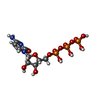 ChemComp-CTP: |
-Macromolecule #3: MAGNESIUM ION
| Macromolecule | Name: MAGNESIUM ION / type: ligand / ID: 3 / Number of copies: 8 / Formula: MG |
|---|---|
| Molecular weight | Theoretical: 24.305 Da |
-Experimental details
-Structure determination
| Method | cryo EM |
|---|---|
 Processing Processing | single particle reconstruction |
| Aggregation state | filament |
- Sample preparation
Sample preparation
| Buffer | pH: 7.9 |
|---|---|
| Vitrification | Cryogen name: ETHANE |
- Electron microscopy
Electron microscopy
| Microscope | FEI TITAN KRIOS |
|---|---|
| Image recording | Film or detector model: GATAN K2 SUMMIT (4k x 4k) / Detector mode: SUPER-RESOLUTION / Average electron dose: 90.0 e/Å2 |
| Electron beam | Acceleration voltage: 300 kV / Electron source:  FIELD EMISSION GUN FIELD EMISSION GUN |
| Electron optics | Illumination mode: FLOOD BEAM / Imaging mode: BRIGHT FIELD |
| Experimental equipment |  Model: Titan Krios / Image courtesy: FEI Company |
- Image processing
Image processing
| Startup model | Type of model: EMDB MAP |
|---|---|
| Final reconstruction | Resolution.type: BY AUTHOR / Resolution: 2.8 Å / Resolution method: FSC 0.5 CUT-OFF / Software - Name: RELION (ver. 3.1) / Number images used: 46236 |
| Initial angle assignment | Type: MAXIMUM LIKELIHOOD / Software - Name: RELION (ver. 3.1) |
| Final angle assignment | Type: MAXIMUM LIKELIHOOD / Software - Name: RELION (ver. 3.1) |
 Movie
Movie Controller
Controller














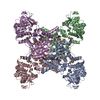
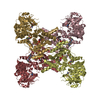
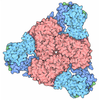

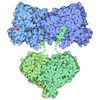

 X (Sec.)
X (Sec.) Y (Row.)
Y (Row.) Z (Col.)
Z (Col.)





















